Newsletter October 2016
 ICRH Global Newsletter ICRH Global Newsletter 31st of October, 2016
|
| PROJECTS |
During the last week of September, the DIFFER Project held a final 2-days symposium in Brussels. |
Uptake project in Kenya A context-specific health sector and community-based participatory approach in a human rights framework, to increase met needs for family planning and contraception. UPTAKE is a five-year multicounty research study being conducted in Kenya, Zambia, and South Africa and it is funded by the World Health Organization. Its objective is to develop, test, refine, and implement an intervention comprising the approach to engage community and health care providers to increase utilization of family planning. In Kenya, the study is being conducted in Kilifi County. Activities conducted in the formative phase to develop the approach to engage the community and healthcare providers include: qualitative research, mapping of family planning services and policies, and scoping reviews |
INPAC meetings in Beijing On 23-24 September 2016, the INPAC project has organized the project’s progress meeting as well as the Scientific Advisor Board (SAB) and Policy Advisor Board (PAB) meetings at the Chinese Medical Association in Beijing, China.
The fruitful outcome laid a good foundation for the future implementation for the INPAC project. More details discussion on the interpreting the results of interventional study and transferring the findings into policies would be conducted during the next SAB meeting on 22-24 November in Ghent, Belgium. |
Drop in centres for key populations ICRH Kenya has drop in centres that provide services and information to key population including female and male sex workers. 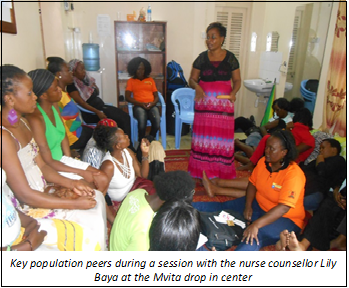 Services provided include STI screening and treatment, HIV testing and counselling, cancer screening, provision of modern contraception methods among other Sexual and Reproductive Health services. Peer education forms part of the services provided by trained peer educators within the organization’s catchment area. Projects targeting key population include LINKAGES, BORESHA, Women’s Health Intervention using SMS for Preventing Pregnancy (WHISPERS), Key Population Implementation Science (KPIS) and Alternative means of livelihood under the UNFPA programs Services provided include STI screening and treatment, HIV testing and counselling, cancer screening, provision of modern contraception methods among other Sexual and Reproductive Health services. Peer education forms part of the services provided by trained peer educators within the organization’s catchment area. Projects targeting key population include LINKAGES, BORESHA, Women’s Health Intervention using SMS for Preventing Pregnancy (WHISPERS), Key Population Implementation Science (KPIS) and Alternative means of livelihood under the UNFPA programs |
| EVENTS |
Launch of the ANSER network
The ANSER network unites 17 academic institutions from around the world and is funded by Ghent University and coordinated by ICRH. Speakers at the launch event will include Elke Sleurs (Belgian State Secretary for Science Policy) and Neil Datta (European Parliamentary Forum on Population & Development), Sietske Steneker (UNFPA) and Metin Gülmezoglu (WHO-HRP). The event starts at 5pm and will be followed by a reception. Registration is free and can be done using the link below. In the days after the launch, on 1 and 2 December, there will be an international ANSER conference aimed at presenting research results in the field of SRHR and discussing their implications for policy. The conference is open to all researchers, policy makers, students and others that are interested in SRHR policy research. You can register for the launch and the conference on: https://congres.ugent.be/SRHR2016. |
Unravelling HIV On 26 November, the HIV Cure Research Centre of Ghent University is organizing an event aimed at raising funds for research into a cure for HIV. Despite the enormous progress in treatment, HIV remains a deadly disease, with 37 million persons infected and only 40% of them on treatment. Research into finding a cure remains an absolute necessity. ‘Unravelling HIV’ is an initiative at Ghent University with the aim to cure HIV. In collaboration with many partners, including restaurants, fashion houses and artists, the University is organizing a fund raising event of which the revenue will go entirely to ‘Unravelling HIV’. Marleen Temmerman will be the host and Luk Alloo will be the presenter. There will be entertainment by among others Sioen and Radio Candip, and food will provided by Belgaqueen, Greenway, Balls & Glory, Julie’s House and many others. This magnificent event takes place on 26 November in the UFO building in Gent. Tickets are 65 Euro per person (drinks not included). Registration: https://congres.ugent.be/hivontrafelen2016
|
Gender norms in early adolescence On 8th and 9th September ICRH researcher Sara De Meyer presented qualitative results of the Global Early Adolescent Study at the ‘Adolescence, Youth and Gender Conference’ in Oxford.
More information about the conference: https://twitter.com/@YLoxford https://www.youtube.com/channel/UCsZkpcrrolOvnzNG2X3lIjg |
Celebrating International Safe Abortion Day in Manhiça, Mozambique Mozambique recently became the fourth African country to decriminalize safe abortion.
|
| ICRH PEOPLE |
An-Sofie Van Parys On 26 September, An-Sofie Van Parys defended her PhD thesis on ‘partner violence in pregnancy, an intervention study in perinatal care’.
The full text of her PhD thesis is available HERE. |
Málica de Melo I The focus of the stay is to receive coaching on quantitative data analysis and quality control. She is working mainly on data from the IQSCI family planning project funding by the Government of Flanders, which includes a component on capacity building of the ICRH Mozambique team in the area of research, with technical support provided by ICRH-Belgium. |
| PUBLICATIONS |
Female genital mutilation (FGM) Estimates of first generation women and girls with female genital mutilation in the European Union, Norway and Switzerland. Luk Van Baelen, Livia Ortensi & Els Leye. Estimates of first generation women and girls with female genital mutilation in the European Union, Norway and Switzerland. Eur J Contracept Reprod Health Care. 2016 Sep 21:1-9. |
Beyond Risk Compensation Clusters of Antiretroviral Treatment (ART) users in sexual networks can modify the impact of ART on HIV incidence. Concerns about risk compensation -increased risk behaviours in response to a perception of reduced HIV transmission risk- after the initiation of ART have largely been dispelled in empirical studies, but other changes in sexual networking patterns may still modify the effects of ART on HIV incidence. Wim Delva, Stéphane Helleringer. Beyond Risk Compensation: Clusters of Antiretroviral Treatment (ART) Users in Sexual Networks Can Modify the Impact of ART on HIV Incidence. PLoS ONE 11(9): e0163159. doi:10.1371/journal. pone.0163159. |
Family planning in Mozambique Results of a survey assessing women's satisfaction with family planning services in Mozambique. Chavane L, Dgedge M, Bailey P, Loquiha O, Aerts M, Temmerman M. Assessing women's satisfaction with family planning services in Mozambique. J Fam Plann Reprod Health Care. 2016 Sep 8. pii: jfprhc-2015-101190. doi: 10.1136/jfprhc-2015-101190. |
Effect of BMI and body weight on pregnancy rates with LNG as emergency contraception A study to estimate the effect of increased body weight and body mass index (BMI) on pregnancy rates with levonorgestrel (LNG) 1.5mg used as emergency contraception (EC). The study reviewed data from 6873 women in four WHO-HRP randomized trials on EC conducted between 1993 and 2010. Participants took either 1.5mg of LNG as a single dose or in two doses 12h apart, up to 120h of unprotected intercourse. Contraceptive efficacy (pregnancy rates) at different weight and BMI categories was evaluated. Festin MP, Peregoudov A, Seuc A, Kiarie J, Temmerman M. Effect of BMI and body weight on pregnancy rates with LNG as emergency contraception: analysis of four WHO HRP studies. Contraception. 2016 Aug 12. pii: S0010-7824(16)30357-2. doi: 0.1016/j.contraception.2016.08.001. |
Participatory approaches in family planning A scoping review on participatory approaches involving community and healthcare providers in family planning/contraceptive information and service provision. As efforts to address unmet need for family planning and contraception (FP/C) accelerate, voluntary use, informed choice and quality must remain at the fore. Active involvement of affected populations has been recognized as one of the key principles in ensuring human rights in the provision of FP/C and in improving quality of care. However, community participation continues to be inadequately addressed in large-scale FP/C programmes. Community and healthcare providers' unequal relationship can be a barrier to successful participation. This scoping review identifies participatory approaches involving both community and healthcare providers for FP/C services and analyzes relevant evidence. The detailed analysis of 25 articles provided information on 28 specific programmes and identified three types of approaches for community and healthcare provider participation in FP/C programmes. The three approaches were: (i) establishment of new groups either health committees to link the health service providers and users or implementation teams to conduct specific activities to improve or extend available health services, (ii) identification of and collaboration with existing community structures to optimise use of health services and (iii) operationalization of tools to facilitate community and healthcare provider collaboration for quality improvement. Integration of community and healthcare provider participation in FP/C provision were conducted through FP/C-only programmes, FP/C-focused programmes and/or as part of a health service package. The rationales behind the interventions varied and may be multiple. Examples include researcher-, NGO- or health service-initiated programmes with clear objectives of improving FP/C service provision or increasing demand for services; facilitating the involvement of community members or service users and, in some cases, may combine socio-economic development and increasing self-reliance or control over sexual and reproductive health. Although a number of studies reported increase in FP/C knowledge and uptake, the lack of robust monitoring and evaluation mechanisms and quantitative and comparable data resulted in difficulties in generating clear recommendations. It is imperative that programmes are systematically designed, evaluated and reported. Steyn PS, Cordero JP, Gichangi P, Smit JA, Nkole T, Kiarie J, Temmerman M. Participatory approaches involving community and healthcare providers in family planning/contraceptive information and service provision: a scoping review. Reprod Health. 2016 Jul 22;13(1):88. doi: 10.1186/s12978-016-0198-9. Review. |
Syphilis Global burden of maternal and congenital syphilis in 2008 and 2012: a health systems modelling study. In 2007, WHO launched a global initiative for the elimination of mother-to-child transmission of syphilis (congenital syphilis). An important aspect of the initiative is strengthening surveillance to monitor progress towards elimination. In 2008, using a health systems model with country data inputs, WHO estimated that 1.4 million maternal syphilis infections caused 520?000 adverse pregnancy outcomes. To assess progress, the authors updated the 2008 estimates and estimated the 2012 global prevalence and cases of maternal and congenital syphilis. Wijesooriya NS, Rochat RW, Kamb ML, Turlapati P, Temmerman M, Broutet N, Newman LM. Global burden of maternal and congenital syphilis in 2008 and 2012: a health systems modelling study. Lancet Glob Health. 2016 Aug;4(8):e525-33. doi: 10.1016/S2214-109X(16)30135-8. |
| Disparities in contraceptive method choices Contraceptive method choice among women in slum and non-slum communities in Nairobi, Kenya. Understanding women's contraceptive method choices is key to enhancing family planning services provision and programming. Currently however, very little research has addressed inter and intra-regional disparities in women's contraceptive method choice. Using data from slum and non-slum contexts in Nairobi, Kenya, the current study investigates the prevalence of and factors associated with contraceptive method choice among women. Ochako R, Izugbara C, Okal J, Askew I, Temmerman M. Contraceptive method choice among women in slum and non-slum communities in Nairobi, Kenya. BMC Womens Health. 2016 Jul 12;16:35. doi: 10.1186/s12905-016-0314-6. |
| Lessons learnt from the CERCA Project A multicomponent intervention to promote adolescent sexual and reproductive health in three Latin America countries: a qualitative post-hoc evaluation. The Community-Embedded Reproductive Health Care for Adolescents (CERCA) Project was implemented in Bolivia, Ecuador and Nicaragua (2011-2014) to test the effectiveness of interventions preventing teenage pregnancies. As the outcome evaluation showed limited impact, a post-hoc process evaluation was carried out to determine if and how CERCA's design, implementation, monitoring and evaluation affected the results. We did a document analysis and conducted 18 in-depth interviews and 21 focus group discussions with stakeholders and beneficiaries. Transcripts were analyzed using directed content analysis. Data showed that CERCA sensitized stakeholders and encouraged the discussion on this sensitive issue. In terms of design, a strong point was the participatory approach; a weak point was that the detailed situation analysis was completed too late. In terms of implementation, a strong point was that multifaceted activities were implemented; a weak point was that the activities were not pilot tested for feasibility/acceptability and evolved substantially throughout the Project. In terms of monitoring, strong points were that regular monitoring kept the Project on track administratively/financially; a weak point was that monitoring indicators did not change as the intervention package changed. In terms of evaluation, weak points were the substantial attrition rate and narrow focus on adolescents. This study provides recommendations for future projects. Ivanova O, Pozo KC, Segura ZE, Vega B, Chandra-Mouli V, Hindin MJ, Temmerman M, Decat P, De Meyer S, Michielsen K. Lessons learnt from the CERCA Project, a multicomponent intervention to promote adolescent sexual and reproductive health in three Latin America countries: a qualitative post-hoc evaluation. Eval Program Plann. 2016 Oct;58:98-105. doi: 10.1016/j.evalprogplan.2016.06.007. Epub 2016 Jun 13. |
Classifying contraceptives Moving towards the goals of FP2020. With the renewed focus on family planning, a clear and transparent understanding is needed for the consistent classification of contraceptives, especially in the commonly used modern/traditional system. The World Health Organization Department of Reproductive Health and Research and the United States Agency for International Development (USAID) therefore convened a technical consultation in January 2015 to address issues related to classifying contraceptives. The consultation defined modern contraceptive methods as having a sound basis in reproductive biology, a precise protocol for correct use and evidence of efficacy under various conditions based on appropriately designed studies. Methods in country programs like Fertility Awareness Based Methods [such as Standard Days Method (SDM) and TwoDay Method], Lactational Amenorrhea Method (LAM) and emergency contraception should be reported as modern. Herbs, charms and vaginal douching are not counted as contraceptive methods as they have no scientific basis in preventing pregnancy nor are in country programs. More research is needed on defining and measuring use of emergency contraceptive methods, to reflect their contribution to reducing unmet need. The ideal contraceptive classification system should be simple, easy to use, clear and consistent, with greater parsimony. Measurement challenges remain but should not be the driving force to determine what methods are counted or reported as modern or not. Family planning programs should consider multiple attributes of contraceptive methods (e.g., level of effectiveness, need for program support, duration of labeled use, hormonal or nonhormonal) to ensure they provide a variety of methods to meet the needs of women and men. Festin MP, Kiarie J, Solo J, Spieler J, Malarcher S, Van Look PF, Temmerman M. Moving towards the goals of FP2020 - classifying contraceptives. Contraception. 2016 Oct;94(4):289-94. doi: 10.1016/j.contraception.2016.05.015. Epub 2016 Jun 7. |
Copper IUDs versus injectable progestin contraception Effects of the copper IUDs versus injectable progestin contraception on pregnancy rates and method discontinuation among women attending termination of pregnancy services in South Africa. The copper intrauterine device (IUD) is under-utilised in South Africa, where injectable progestin contraception (IPC) dominates contraception usage. There is a lack of robust comparative data on these contraceptive options to inform policy, programs, clinical counseling, and women's choices. Hofmeyr GJ, Singata-Madliki M, Lawrie TA, Bergel E, Temmerman M. Effects of the copper intrauterine device versus injectable progestin contraception on pregnancy rates and method discontinuation among women attending termination of pregnancy services in South Africa: a pragmatic randomized controlled trial. Reprod Health. 2016 Apr 18;13:42. doi: 10.1186/s12978-016-0153-9. |
Engaging with community-based mid-level providers for promoting the use of modern contraceptive methods Results from two innovative birth spacing interventions in rural Pakistan. Family planning (FP) interventions aimed at reducing population growth have been negligible during the last two decades in Pakistan. Innovative FP interventions that help reduce the growing population burden are the need of the hour. Marie Stopes Society--Pakistan implemented an operational research project--'Evidence for Innovating to Save Lives', to explore effective and viable intervention models that can promote healthy timing and spacing of pregnancy in rural and under-served communities of Sindh, Punjab and Khyber Pakhtunkhwa provinces of Pakistan. Azmat SK, Hameed W, Hamza HB, Mustafa G, Ishaque M, Abbas G4 Khan OF, Asghar J, Munroe E, Ali S, Hussain W, Ali S, Ahmed A, Ali M, Temmerman M. Engaging with community-based public and private mid-level providers for promoting the use of modern contraceptive methods in rural Pakistan: results from two innovative birth spacing interventions. Reprod Health. 2016 Mar 17;13:25. doi: 10.1186/s12978-016-0145-9. |
Patton G, Temmerman M. Evidence and Evidence Gaps in Adolescent Health. J Adolesc Health. 2016 Oct;59(4S):S1-S3. doi: 10.1016/j.jadohealth.2016.08.001. No abstract available. Temmerman M. Caesarean section surgical techniques: all equally safe. Lancet. 2016 Jul 2;388(10039):8-9. doi: 10.1016/S0140-6736(16)30355-5. Epub 2016 May 4. No abstract available. Kuruvilla S, Bustreo F, Kuo T, Mishra CK, Taylor K, Fogstad H, Gupta GR, Gilmore K, Temmerman M, Thomas J, Rasanathan K, Chaiban T, Mohan A, Gruending A, Schweitzer J, Dini HS, Borrazzo J, Fassil H, Gronseth L, Khosla R, Cheeseman R, Gorna R, McDougall L, Toure K, Rogers K, Dodson K, Sharma A, Seoane M, Costello A. The Global strategy for women's, children's and adolescents' health (2016-2030): a roadmap based on evidence and country experience. Bull World Health Organ. 2016 May 1;94(5):398-400. doi: 10.2471/BLT.16.170431. Epub 2016 May 2. No abstract available. Depoortere E, Matthews Z, Nove A, Hanrahan F, Kerstiëns B, Matthiessen L, Temmerman M, Draghia-Akli R; speakers at the European Commission conference “Together for the next generation: research and innovation for maternal and newborn health” of Dec 8, 2015. The need for innovation and implementation research for maternal and newborn health. Lancet. 2016 Sep 15. pii: S0140-6736(16)31662-2. doi: 10.1016/S0140-6736(16)31662-2. No abstract available. |


 South Africa; Tete, Mozambique; Mombasa, Kenya; and Mysore, India), the developed intervention had been successful in improving the use of sexual and reproductive health services by female sex workers, and through the south-south exchange between India and Africa, African sex workers had been empowered. The lessons learned and the possibility to replicate some of the intervention components on a larger scale will be further discussed in each of the countries, infographics will be developed and shared with international stakeholders, and key findings will be disseminated through presentations at conferences and publications in scientific journals. The symposium was officially closed by H.E. Johnson Weru, ambassador of the Republic of Kenya.
South Africa; Tete, Mozambique; Mombasa, Kenya; and Mysore, India), the developed intervention had been successful in improving the use of sexual and reproductive health services by female sex workers, and through the south-south exchange between India and Africa, African sex workers had been empowered. The lessons learned and the possibility to replicate some of the intervention components on a larger scale will be further discussed in each of the countries, infographics will be developed and shared with international stakeholders, and key findings will be disseminated through presentations at conferences and publications in scientific journals. The symposium was officially closed by H.E. Johnson Weru, ambassador of the Republic of Kenya.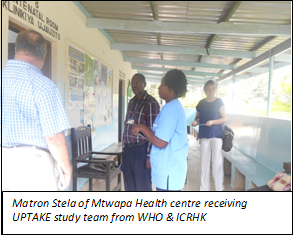 on quality of care and community participation. After development, it was tested for technical, schedule, cultural, and operational feasibility through a community dialogue. The approach was found to be feasible and the intervention developed and pretested for appropriateness through a County meeting. Currently, the UPTAKE team is in the process of developing the intervention protocol and tools. The intervention will be implemented through a quasi-experiment.
on quality of care and community participation. After development, it was tested for technical, schedule, cultural, and operational feasibility through a community dialogue. The approach was found to be feasible and the intervention developed and pretested for appropriateness through a County meeting. Currently, the UPTAKE team is in the process of developing the intervention protocol and tools. The intervention will be implemented through a quasi-experiment.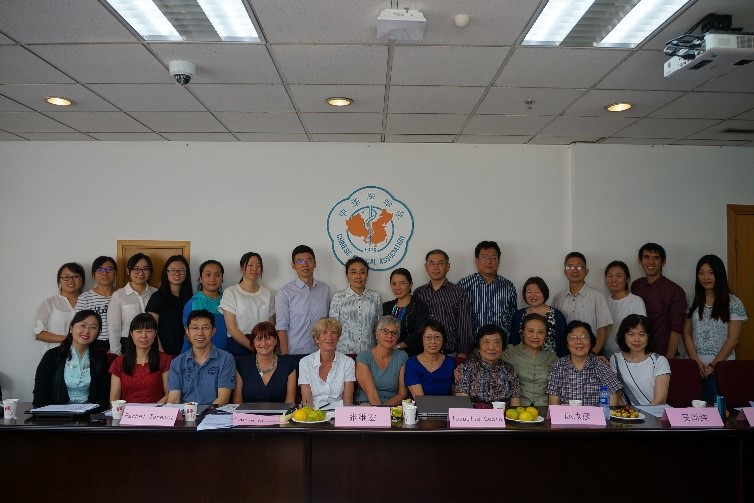 The two-day event had gathered altogether 7 consortiums with 22 members, as well as 11 expert members from the SAB and PAB committee. During the meeting, the progress of the INPAC project was discussed and further action plans for promoting INPAC were set up. The board members shared with the group their professional experience and plentiful constructive feedbacks and suggestions for the project.
The two-day event had gathered altogether 7 consortiums with 22 members, as well as 11 expert members from the SAB and PAB committee. During the meeting, the progress of the INPAC project was discussed and further action plans for promoting INPAC were set up. The board members shared with the group their professional experience and plentiful constructive feedbacks and suggestions for the project. The Academic Network for Sexual and Reproductive Health and Rights Policy will be officially launched on 30 November in Ghent.
The Academic Network for Sexual and Reproductive Health and Rights Policy will be officially launched on 30 November in Ghent.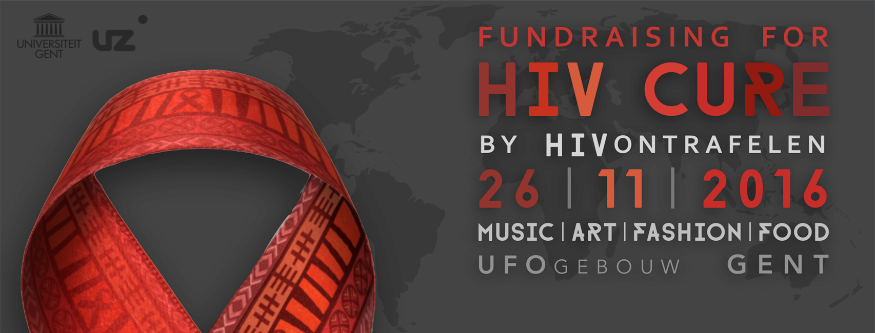
 The presented research about perceived risks for boys’ and girls’ health when entering adolescence and on gender norms in early adolescents’ romantic relationships indicate the need for more research on how gender norms in early adolescence can influence sexual and reproductive health and wellbeing in a later stage of adolescence. The GEAS consortium is looking for funding to investigate this research question by implementing a longitudinal cohort study in 15 countries.
The presented research about perceived risks for boys’ and girls’ health when entering adolescence and on gender norms in early adolescents’ romantic relationships indicate the need for more research on how gender norms in early adolescence can influence sexual and reproductive health and wellbeing in a later stage of adolescence. The GEAS consortium is looking for funding to investigate this research question by implementing a longitudinal cohort study in 15 countries.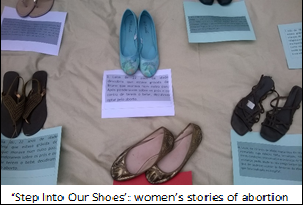 On 28 September, ICRH-Mozambique together with the Network for Reproductive and Sexual Health and Rights, celebrated International Safe Abortion Day in Manhiça, one of our project sites. The programme included speeches by local authorities, theatre and debates on safe abortion and the new legislation that decriminalises the practice in Mozambique. The event was covered by ICRH’s partner, the Xinavane Community Radio station, and included an exhibition of shoes accompanied by women’s stories of abortion, in line with the International “Step Into Our Shoes” campaign which aimed to normalize and reduce stigma around abortion. ICRH-M is working with the Ministry of Health and other partners to lobby for and support the roll-out of accessible safe abortion services.
On 28 September, ICRH-Mozambique together with the Network for Reproductive and Sexual Health and Rights, celebrated International Safe Abortion Day in Manhiça, one of our project sites. The programme included speeches by local authorities, theatre and debates on safe abortion and the new legislation that decriminalises the practice in Mozambique. The event was covered by ICRH’s partner, the Xinavane Community Radio station, and included an exhibition of shoes accompanied by women’s stories of abortion, in line with the International “Step Into Our Shoes” campaign which aimed to normalize and reduce stigma around abortion. ICRH-M is working with the Ministry of Health and other partners to lobby for and support the roll-out of accessible safe abortion services. CRH-Mozambique researcher Málica de Melo is currently on a research stay at ICRH Belgium for 1 month.
CRH-Mozambique researcher Málica de Melo is currently on a research stay at ICRH Belgium for 1 month.